期末复习:Unit 6 topic 1 单元课件(共47张PPT)
文档属性
| 名称 | 期末复习:Unit 6 topic 1 单元课件(共47张PPT) | 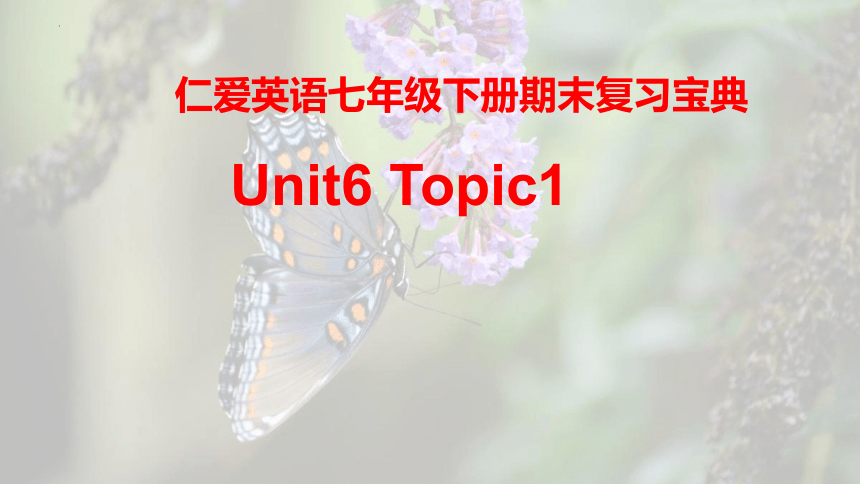 | |
| 格式 | pptx | ||
| 文件大小 | 1.8MB | ||
| 资源类型 | 教案 | ||
| 版本资源 | 仁爱科普版 | ||
| 科目 | 英语 | ||
| 更新时间 | 2022-06-11 06:37:23 | ||
图片预览

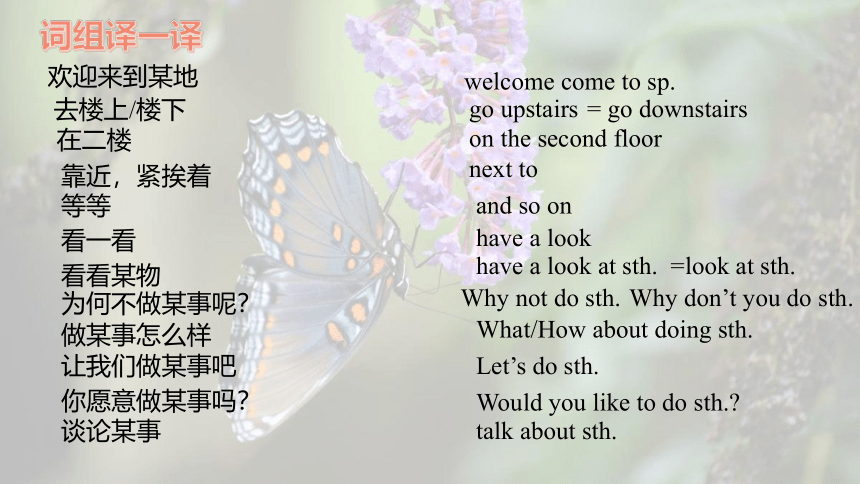
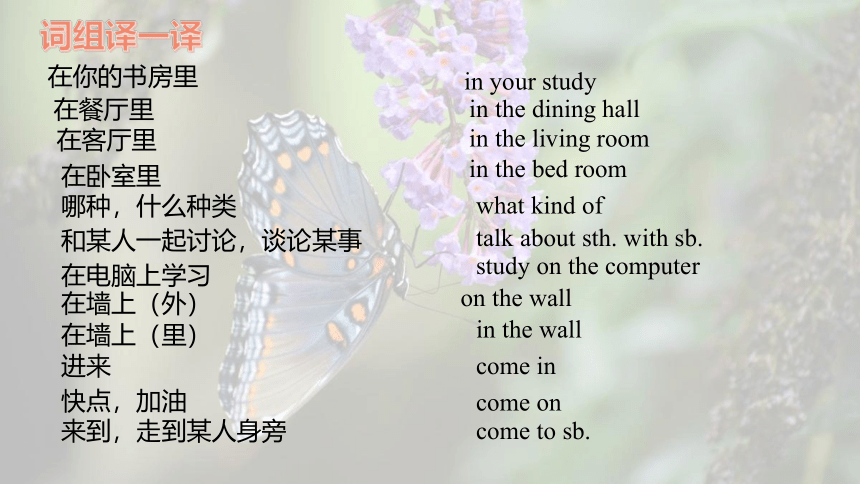
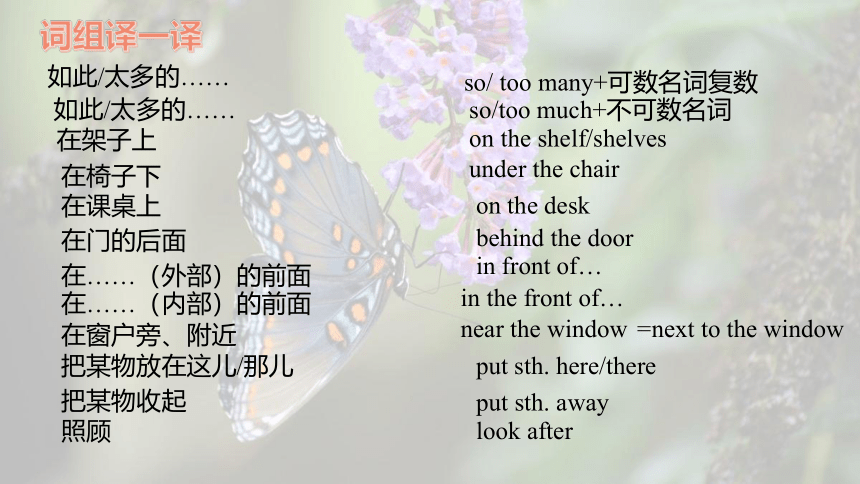
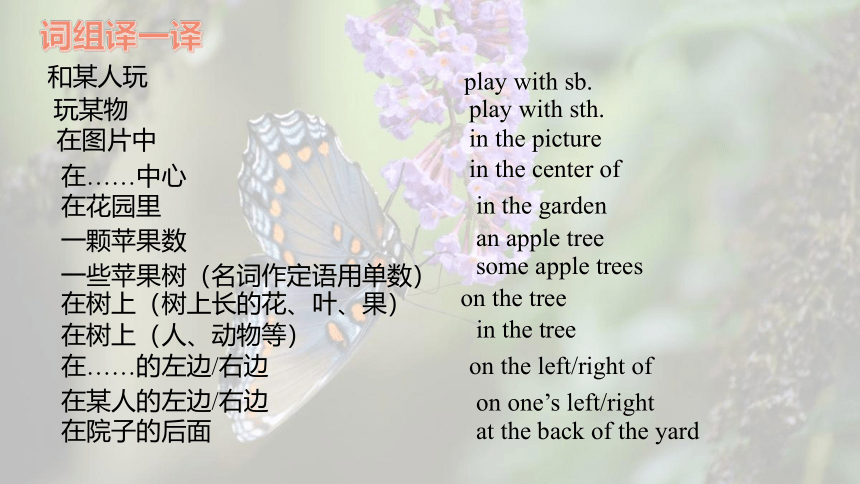
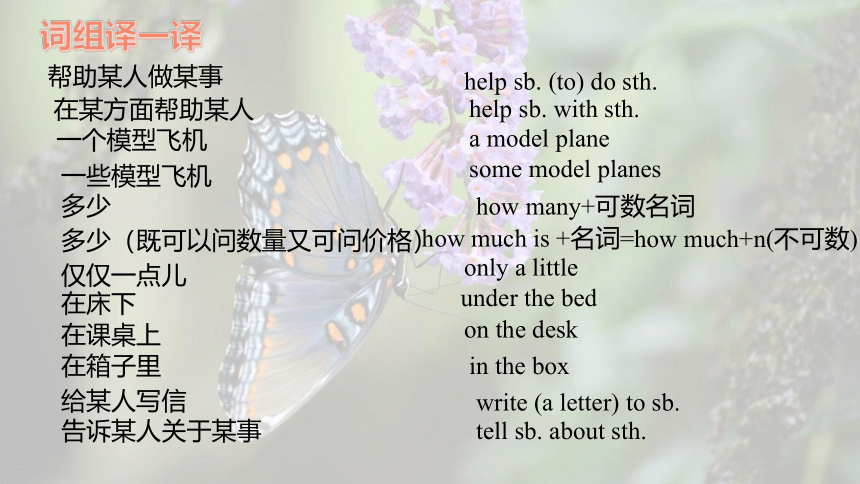
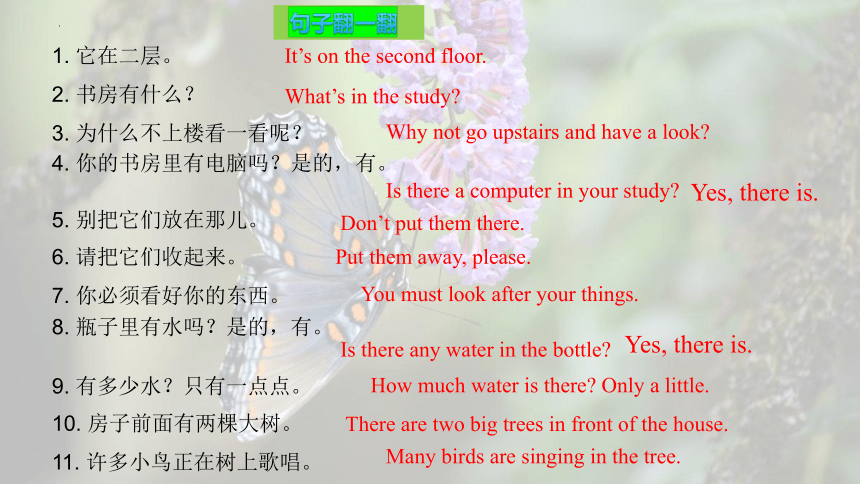
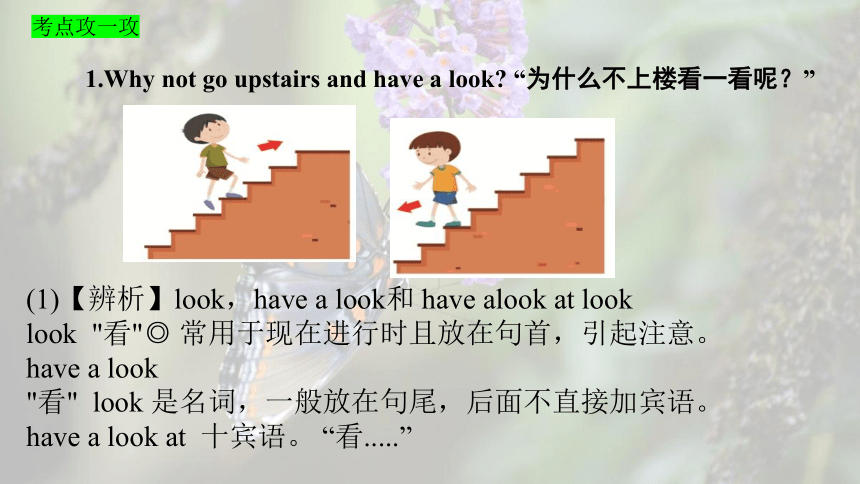

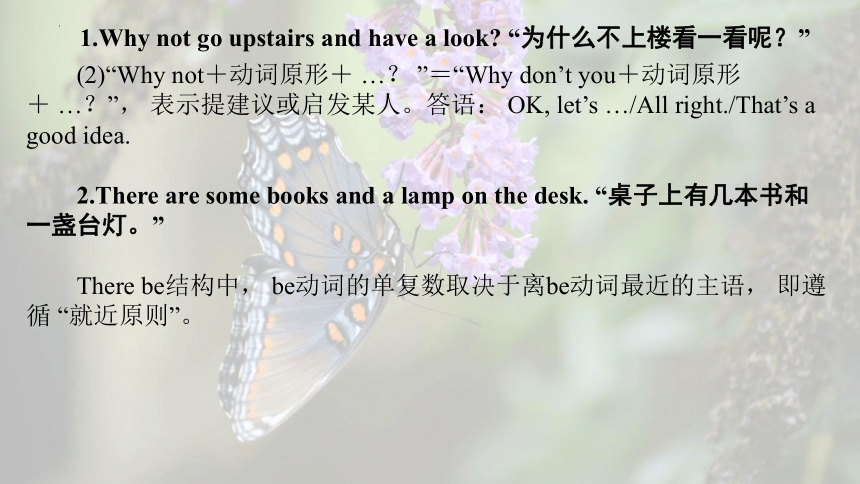
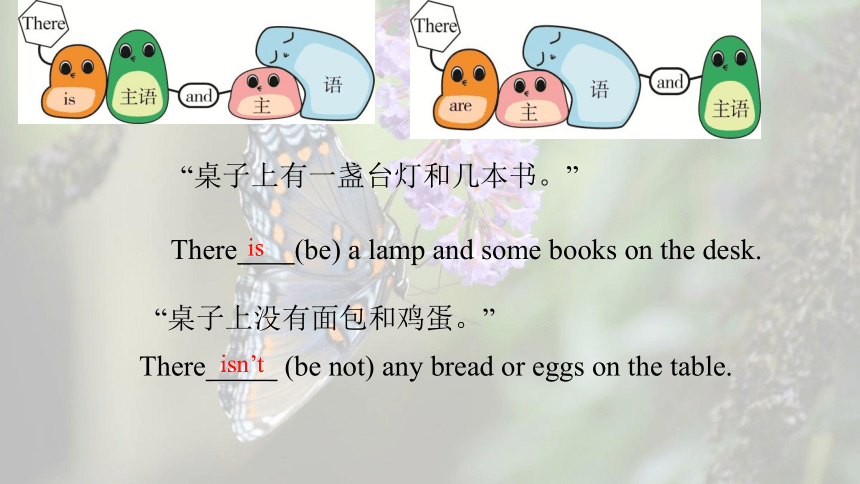
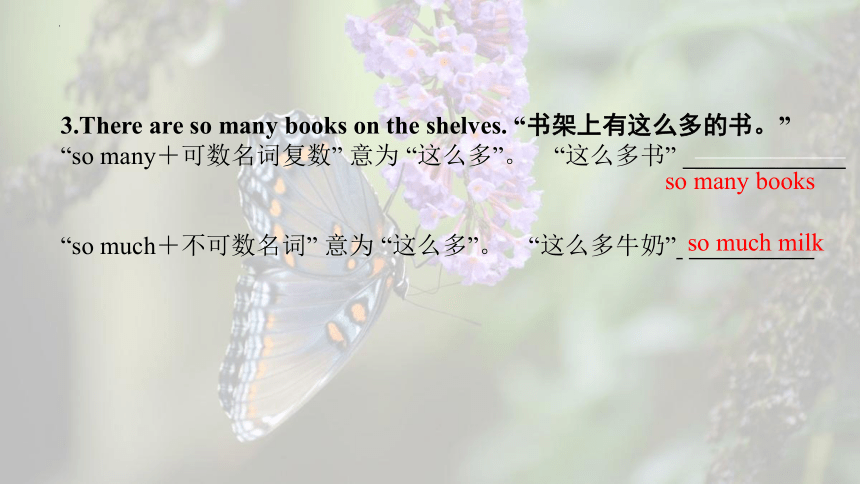
文档简介
(共47张PPT)
Unit6 Topic1
仁爱英语七年级下册期末复习宝典
词组译一译
欢迎来到某地
去楼上/楼下
在二楼
等等
靠近,紧挨着
看一看
看看某物
为何不做某事呢?
做某事怎么样
让我们做某事吧
你愿意做某事吗?
谈论某事
welcome come to sp.
= go downstairs
go upstairs
on the second floor
next to
and so on
have a look
have a look at sth.
Why not do sth.
=look at sth.
What/How about doing sth.
Let’s do sth.
talk about sth.
Would you like to do sth.
Why don’t you do sth.
词组译一译
在你的书房里
在餐厅里
在客厅里
哪种,什么种类
在卧室里
和某人一起讨论,谈论某事
在电脑上学习
在墙上(外)
在墙上(里)
进来
快点,加油
来到,走到某人身旁
in your study
in the dining hall
in the living room
in the bed room
what kind of
talk about sth. with sb.
study on the computer
on the wall
in the wall
come in
come to sb.
come on
词组译一译
如此/太多的……
如此/太多的……
在架子上
在课桌上
在椅子下
在门的后面
在……(外部)的前面
在……(内部)的前面
在窗户旁、附近
把某物放在这儿/那儿
把某物收起
照顾
so/ too many+可数名词复数
so/too much+不可数名词
on the shelf/shelves
under the chair
on the desk
behind the door
in front of…
in the front of…
near the window
put sth. here/there
look after
put sth. away
=next to the window
词组译一译
和某人玩
玩某物
在图片中
在花园里
在……中心
一颗苹果数
一些苹果树(名词作定语用单数)
在树上(树上长的花、叶、果)
在树上(人、动物等)
在……的左边/右边
在某人的左边/右边
在院子的后面
play with sb.
play with sth.
in the picture
in the center of
in the garden
an apple tree
some apple trees
on the tree
in the tree
on the left/right of
at the back of the yard
on one’s left/right
词组译一译
帮助某人做某事
在某方面帮助某人
一个模型飞机
多少
一些模型飞机
多少(既可以问数量又可问价格)
仅仅一点儿
在床下
在课桌上
在箱子里
给某人写信
告诉某人关于某事
help sb. (to) do sth.
help sb. with sth.
a model plane
some model planes
how many+可数名词
how much is +名词
only a little
under the bed
on the desk
in the box
tell sb. about sth.
write (a letter) to sb.
=how much+n(不可数)
1. 它在二层。
2. 书房有什么?
3. 为什么不上楼看一看呢?
4. 你的书房里有电脑吗?是的,有。
5. 别把它们放在那儿。
6. 请把它们收起来。
7. 你必须看好你的东西。
8. 瓶子里有水吗?是的,有。
9. 有多少水?只有一点点。
10. 房子前面有两棵大树。
11. 许多小鸟正在树上歌唱。
It’s on the second floor.
What’s in the study
Why not go upstairs and have a look
Is there a computer in your study
Don’t put them there.
Put them away, please.
You must look after your things.
Is there any water in the bottle
How much water is there Only a little.
There are two big trees in front of the house.
Many birds are singing in the tree.
句子翻一翻
Yes, there is.
Yes, there is.
考点攻一攻
(1)【辨析】look,have a look和 have alook at look
look "看"◎ 常用于现在进行时且放在句首,引起注意。
have a look
"看" look 是名词,一般放在句尾,后面不直接加宾语。
have a look at 十宾语。 “看.....”
1.Why not go upstairs and have a look “为什么不上楼看一看呢?”
( )May I _______ your new watch
A.look B.have a look C.have a look a
C
A
B
( )Oh, ! His name is on Page One.
A.look B.have a look C.have a look at
( )These flowers are very beautiful. Why don’t you come and ? A.look B.have a look C.have a look at
(2)“Why not+动词原形+ …? ”=“Why don’t you+动词原形+ …?”, 表示提建议或启发某人。答语: OK, let’s …/All right./That’s a good idea.
2.There are some books and a lamp on the desk. “桌子上有几本书和一盏台灯。”
There be结构中, be动词的单复数取决于离be动词最近的主语, 即遵循 “就近原则”。
1.Why not go upstairs and have a look “为什么不上楼看一看呢?”
There ____ (be not) any bread or eggs on the table.
There __ (be) a lamp and some books on the desk.
is
isn’t
“桌子上没有面包和鸡蛋。”
“桌子上有一盏台灯和几本书。”
3.There are so many books on the shelves. “书架上有这么多的书。”
“so many+可数名词复数” 意为 “这么多”。 “这么多书” _——————
“so much+不可数名词” 意为 “这么多”。 “这么多牛奶” __________
so many books
so much milk
4.Don’t put them here. Put them away, please. “不要把它们放这儿。请把它们收好。”
put away “整理;收拾” 用法:
代词作宾语时应放在put和away的中间。 名词作宾语, 既可放在中间, 也可放在后面。
Put the book away.= ————————
类似用法的短语: put on, try on等。
Put away the book.
“把书收好。”
( )—Jimmy, the books are everywhere in your study. —Sorry, Mom. I’ll at once(立刻).
A.put them on B.put them away C.put them up
( ) Please ________ your books.A.take up B.put away C.give out
B
B
5.There are two students in the front of the classroom. “教室前面有两个学生。” 【辨析】in front of 和 in the front of
in front of意为“在(某物或某场所外部)的前面”。
in the front of意为“在(某物或某场所内部)的前面”。
There is a tree___________ the classroom. “教室前面有一棵树。”(树在教室外)
The teacher is standing ___________ the classroom. “老师站在教室的前面。”(老师在教室里)
( )There’re ten people waiting for the doctor me.A.behind B.in front of C.in the front of
in front of
in the front of
B
6.I love playing on the computer in the study. “我喜欢在书房玩电脑。”
玩电脑
play
+宾语 “玩游戏”__________________
+with sb./sth.“和某人一起玩;玩……物品”;“和狗狗一起玩”________________
the +西洋乐器;“弹钢琴”_________________
play games
play football
play the piano
+球类(牌类)活动(不加冠词the)踢足球______________.
play with the dog
比较: there be句型强调的是客观存在; have/has强调的是所属关系。( )We ordered(点餐) beef noodles(牛肉面), but any beef(牛肉) in the noodles.A.there is B.there isn’t C.there aren’t
( )—Excuse me, are there any banks around here — __ , but there is one on the street corner.A.Yes, there are B.No, there isn’t C.No, there aren’t
B
C
7. It’s on the second floor. There is a study next to my bedroom. 它在二楼。我卧室的隔壁有一间书房。
(1) floor“地板;楼层”,常以介词on连用。
(2) study 名词,“书房”,复数为studies.
study还可以作动词,“学习,研究”。
(3) next to 在……近旁,紧邻。
8.There is a sofa, a desk, some books and so on. 有一个沙发、一张书桌、一些书等。
and so on意为“等等”,列举事物时用于句尾,表示列举完了同类事物。
9. Why not go upstairs and have a look 为什么不上楼来看看呢?
(1) go upstairs 上楼。反义词组为:go downstairs下楼。
(2) have a look “看一看,瞧一瞧”。
have a look at sth. 看一看某物
10. What is on your desk 你书桌上有什么?
“What’s + 介词短语?”用来询问“某处有什么?”,答语应该用there be句型。
11. On the left of the yard, there is a kitchen and a dining room.
在院子的左边,有一个厨房和一个餐厅。
left :①名词“左,左边”;②形容词“左边的”。
turn left向左转;on the left of...在……的左边。
12. Don’t put them there. Put them away, please.
别把它们(钥匙)放在那儿,请把它们收起来放好。
(1) Don’t put them there.是否定形式的祈使句。其句型结构为Don’t +动词原形。
(2) put away意为“将……收起”,是“及物动词+副词”构成的动词短语,相当于及物动词。宾语是人称代词时用宾格,代词必须放在动词与副词中间;如果宾语是名词,既可以放中间也可以放后面。
14. How many model planes are there 有几架模型飞机?
本句是“how many +可数名词复数+ are there +地点状语?”句型,回答用there be+数词(+名词+地点状语)。
对不可数名词前的词或短语提问,用“how much+不可数名词+is there + 地点状语?”。
13. Some birds are singing in the tree.一些鸟正在树上唱歌。
in the tree“在树上”,并非树上固有,是外来的东西在树上;
on the tree在树上。表示本来长在树上的叶子或果实。
学以致用,你掌握了吗?
一、句型转换。
There are four bedrooms in the house.
(对画线部分提问)
______ ______ bedrooms are there in the house
2. Put these books away on the shelf, please.(改为同义句)
_____ _____ these books on the shelf, please.
3. There are two books on the desk.(对画线部分提问)
________ on the desk
How many
Put away
What’s
一:There be 句型
1. 定义:表示某处存在某物或某人。
结构:
(1) There is +单数可数名词/不可数名词+ 地点状语.
(2) There are +复数名词+地点状语.
例:
语法学一学
树上有一只鸟。
There is a bird in the tree.
树下有两个男孩。
There are two boys under the tree.
3. There be句型的否定句
There be句型的否定式是在be后加上not或no。
注意not和no的不同:not是副词,no为形容词,not a/an/any + n. 相当于no+ n.。
例:
There are some photos on the wall.(改为否定句)
→There aren't any photos on the wall.
=There are no photos on the wall.
4. There be句型的一般疑问句
There be句型的一般疑问句变化是把be动词调到句首,再在句尾加上问号即可。但要注意:当肯定句中有some时,要将其改为any(否定变化也一样)。
There is some water on Mars.(改为否定句)
→ Is there any water on Mars
5. There be句型的时态
be可以有现在时(there is/are)、过去时(there was/were)、将来时(there is/are going to be或there will be);还可用there must be ,there can’t be, there used to be等。
如:
There will be a party this evening.
6. there be 句型的主谓一致:
There be 结构中的be动词要和后面所跟名词保持一致,遵循就近原则。
我们教室里有一位老师和许多学生。
There is a teacher and many students in our classroom.
树下有两个男孩,一个女孩。
There are two boys and a girl under the tree.
7.特殊疑问句
1. 名词被划线时:
What’s + 地点介词短语?
2. 量词被划线时:
How many+可数名词复数+are there+地点?
How much +不可数名词+is there+地点?
—How many books _________ on the desk
—There are three.
—How much water _________ in the bottle
—Only a little.
are there
is there
8.There be 与 have/has 的区别
There be 侧重 “存在关系”, 表示“某地存在某人/某物” 。如: 桌子上有本书
There is a book on the desk.
have/has侧重 “所属关系” ,表示“某人/某物拥有……”。如:她有一只狗。
She has a dog.
在……里
在……上
在…… (外部的)后面
在……下面
在……旁边,附近
在……近旁,紧邻
在……(外部的)前面
在……(内部的)前面
在……中央
在……左/右边
在…… (内部的)后面
in
on
behind
under
near
next to
in front of
in the front of
in the center of
on the left/right of
at the back of
二. 介词Prepositions
语法学一学
方位介词用法
介词 用法 例句
in
on
1. in,at,on
盒子里有个球。
A ball is in the box.
我的书包在桌子上。
My bag is on the desk.
“在……里面”,表示在某范围或空间的内部。
“在……上面”,表示在某个物体的表面上,且与物体表面接触。
2. on; above 与 below;over 与under
on, over,above都表示“在……的上面”
on 表示“在某事物表面上”
over表示“正上方”,
above只表示“斜上方”
On
On
Over
Under
Above
Below
2. on; above 与 below;over 与under
① above的意思是“在……之上”,斜上方,反义词是below。如:
The plane flew above the clouds.飞机在云层上面飞行。
The Dead Sea is below sea level.死海的海面低于海平面。
②over的意思是“在……的正上方”,表示垂直之上,其反义词是under。如:
There is a bridge over the river.河上有座桥。
There is a ball under the desk.桌子下面有一个球。
at the back of
3. 表示“在……前/后”的介词图示例
in the front of
behind
in front of
①in front of 表示“在……之前(范围外)”。
如:
②in the front of表示“在……的前部(范围内)”。
如:
教室前面有一些树。
There are some trees in front of the classroom.
我们的老师通常站在教室前面。
Our teacher usually stands in the front of the classroom.
③behind意为“ 在……后面”,是in front of的反义词。
at the back of意为“在……的后部”,与in the front of互为反
义词组。
如:
那个男孩躲在一扇门后。
The boy was hiding behind a door.
我们教室后面有一副画。
There is a picture at the back of our classroom.
between 表示“两者之间”,常和and连用构成短语between…and…
among 表示“在……之间”(三个或三个以上)
例:
5. 表示“在……之间”: between, among
比赛在中国队和美国队之间进行。
The match is between a American team and a Chinese team.
两个村庄之间
between the two villages
6.其它方位介词
介词 用法 例句
to 表示“到,去,向”。 Will you go to the cinema
你去看电影吗?
through 表示是 “从内部穿过”。 The street is too narrow for the bus to go through.
对汽车来说,通过这条街道太窄了。
across 表示从表面“横穿”。 A bus is going across the street.
一辆公共汽车正横穿马路。
in在里面on在上,by和beside在近旁;
above表示在上方,below恰好为反向。
若表正上用over,under表示正下方。
in front of表在前,反义behind在后面。
从里穿过用through,表面通过across。
进到里面用into,落到上面用onto。
from表示自何方,to和towards表朝向。
小小介词用处大,反复实践掌握它。
方位介词记忆歌诀
易错点1
through/across辨析
across与through都表示“穿过”,但across表示动作是在某个物体的表面进行的; through表示动作是在某一物体内部或空间里进行的。乘船过海或过河用across,表示通过门、窗户、森林等用through。
例:
He can swim across the river.他能游过这条河。
They walked through the forest.他们走过了森林。
B
A
A
B
B
易错点2
in / to / on辨析
in 表示在某一地区之内的方位(属于该范围)
to 表示在某一地区之外的方位(不属于该范围)
on 表示两地点相邻、接壤
A
B is in the east of A.
B is to the east of A.
B is on the east of A.
易错点3
容易混淆的方位介词短语
in bed 表示因病卧床或躺在床上休息,bed不是指具体的某张床,前面不用冠词。
on the bed 表示“在某张床上”。
in the wall 在墙上,指某物镶嵌在墙内或在墙上的洞、钉等。
on the wall 在墙上,指某物在墙的表面上,如图画、钟表、黑板等。
易错点3
容易混淆的方位介词短语
on the newspaper 在报纸上,指报纸表面上的东西。
in the newspaper 在报纸上,指报纸上的内容。
on the tree 在树上,指树本身的东西,如树叶、果实。
in the tree 在树上,指不是树本身的东西,如树上的小鸟等。
在教育局组织的“手拉手”活动中,来自乡村小学校的Li hua对于他所看到的城市学校很有感触,于是他写了一篇作文向他的同班同学做了介绍。假设你就是Li hua,根据下面的提示,以Their School为题,写一篇作文。以there be句式为主,60词左右。提示:1.学校很大很漂亮,有许多树和花,像花园一样; 2.有图书馆、电脑房、实验室等; 3.学生能够学到很多知识。
话题作文
Their school【参考范文】 Their school is big and beautiful. It’s like a big garden. There are five teaching buildings in the school. In front of the teaching buildings, there are lots of trees and flowers. On the second floor there is a big reading room, two computer rooms and three science labs. The students love playing computers. The reading room opens from Monday to Friday. Many students read books in it. They learn a lot from those books. They all like their school very much.
Thank you!
Unit6 Topic1
仁爱英语七年级下册期末复习宝典
词组译一译
欢迎来到某地
去楼上/楼下
在二楼
等等
靠近,紧挨着
看一看
看看某物
为何不做某事呢?
做某事怎么样
让我们做某事吧
你愿意做某事吗?
谈论某事
welcome come to sp.
= go downstairs
go upstairs
on the second floor
next to
and so on
have a look
have a look at sth.
Why not do sth.
=look at sth.
What/How about doing sth.
Let’s do sth.
talk about sth.
Would you like to do sth.
Why don’t you do sth.
词组译一译
在你的书房里
在餐厅里
在客厅里
哪种,什么种类
在卧室里
和某人一起讨论,谈论某事
在电脑上学习
在墙上(外)
在墙上(里)
进来
快点,加油
来到,走到某人身旁
in your study
in the dining hall
in the living room
in the bed room
what kind of
talk about sth. with sb.
study on the computer
on the wall
in the wall
come in
come to sb.
come on
词组译一译
如此/太多的……
如此/太多的……
在架子上
在课桌上
在椅子下
在门的后面
在……(外部)的前面
在……(内部)的前面
在窗户旁、附近
把某物放在这儿/那儿
把某物收起
照顾
so/ too many+可数名词复数
so/too much+不可数名词
on the shelf/shelves
under the chair
on the desk
behind the door
in front of…
in the front of…
near the window
put sth. here/there
look after
put sth. away
=next to the window
词组译一译
和某人玩
玩某物
在图片中
在花园里
在……中心
一颗苹果数
一些苹果树(名词作定语用单数)
在树上(树上长的花、叶、果)
在树上(人、动物等)
在……的左边/右边
在某人的左边/右边
在院子的后面
play with sb.
play with sth.
in the picture
in the center of
in the garden
an apple tree
some apple trees
on the tree
in the tree
on the left/right of
at the back of the yard
on one’s left/right
词组译一译
帮助某人做某事
在某方面帮助某人
一个模型飞机
多少
一些模型飞机
多少(既可以问数量又可问价格)
仅仅一点儿
在床下
在课桌上
在箱子里
给某人写信
告诉某人关于某事
help sb. (to) do sth.
help sb. with sth.
a model plane
some model planes
how many+可数名词
how much is +名词
only a little
under the bed
on the desk
in the box
tell sb. about sth.
write (a letter) to sb.
=how much+n(不可数)
1. 它在二层。
2. 书房有什么?
3. 为什么不上楼看一看呢?
4. 你的书房里有电脑吗?是的,有。
5. 别把它们放在那儿。
6. 请把它们收起来。
7. 你必须看好你的东西。
8. 瓶子里有水吗?是的,有。
9. 有多少水?只有一点点。
10. 房子前面有两棵大树。
11. 许多小鸟正在树上歌唱。
It’s on the second floor.
What’s in the study
Why not go upstairs and have a look
Is there a computer in your study
Don’t put them there.
Put them away, please.
You must look after your things.
Is there any water in the bottle
How much water is there Only a little.
There are two big trees in front of the house.
Many birds are singing in the tree.
句子翻一翻
Yes, there is.
Yes, there is.
考点攻一攻
(1)【辨析】look,have a look和 have alook at look
look "看"◎ 常用于现在进行时且放在句首,引起注意。
have a look
"看" look 是名词,一般放在句尾,后面不直接加宾语。
have a look at 十宾语。 “看.....”
1.Why not go upstairs and have a look “为什么不上楼看一看呢?”
( )May I _______ your new watch
A.look B.have a look C.have a look a
C
A
B
( )Oh, ! His name is on Page One.
A.look B.have a look C.have a look at
( )These flowers are very beautiful. Why don’t you come and ? A.look B.have a look C.have a look at
(2)“Why not+动词原形+ …? ”=“Why don’t you+动词原形+ …?”, 表示提建议或启发某人。答语: OK, let’s …/All right./That’s a good idea.
2.There are some books and a lamp on the desk. “桌子上有几本书和一盏台灯。”
There be结构中, be动词的单复数取决于离be动词最近的主语, 即遵循 “就近原则”。
1.Why not go upstairs and have a look “为什么不上楼看一看呢?”
There ____ (be not) any bread or eggs on the table.
There __ (be) a lamp and some books on the desk.
is
isn’t
“桌子上没有面包和鸡蛋。”
“桌子上有一盏台灯和几本书。”
3.There are so many books on the shelves. “书架上有这么多的书。”
“so many+可数名词复数” 意为 “这么多”。 “这么多书” _——————
“so much+不可数名词” 意为 “这么多”。 “这么多牛奶” __________
so many books
so much milk
4.Don’t put them here. Put them away, please. “不要把它们放这儿。请把它们收好。”
put away “整理;收拾” 用法:
代词作宾语时应放在put和away的中间。 名词作宾语, 既可放在中间, 也可放在后面。
Put the book away.= ————————
类似用法的短语: put on, try on等。
Put away the book.
“把书收好。”
( )—Jimmy, the books are everywhere in your study. —Sorry, Mom. I’ll at once(立刻).
A.put them on B.put them away C.put them up
( ) Please ________ your books.A.take up B.put away C.give out
B
B
5.There are two students in the front of the classroom. “教室前面有两个学生。” 【辨析】in front of 和 in the front of
in front of意为“在(某物或某场所外部)的前面”。
in the front of意为“在(某物或某场所内部)的前面”。
There is a tree___________ the classroom. “教室前面有一棵树。”(树在教室外)
The teacher is standing ___________ the classroom. “老师站在教室的前面。”(老师在教室里)
( )There’re ten people waiting for the doctor me.A.behind B.in front of C.in the front of
in front of
in the front of
B
6.I love playing on the computer in the study. “我喜欢在书房玩电脑。”
玩电脑
play
+宾语 “玩游戏”__________________
+with sb./sth.“和某人一起玩;玩……物品”;“和狗狗一起玩”________________
the +西洋乐器;“弹钢琴”_________________
play games
play football
play the piano
+球类(牌类)活动(不加冠词the)踢足球______________.
play with the dog
比较: there be句型强调的是客观存在; have/has强调的是所属关系。( )We ordered(点餐) beef noodles(牛肉面), but any beef(牛肉) in the noodles.A.there is B.there isn’t C.there aren’t
( )—Excuse me, are there any banks around here — __ , but there is one on the street corner.A.Yes, there are B.No, there isn’t C.No, there aren’t
B
C
7. It’s on the second floor. There is a study next to my bedroom. 它在二楼。我卧室的隔壁有一间书房。
(1) floor“地板;楼层”,常以介词on连用。
(2) study 名词,“书房”,复数为studies.
study还可以作动词,“学习,研究”。
(3) next to 在……近旁,紧邻。
8.There is a sofa, a desk, some books and so on. 有一个沙发、一张书桌、一些书等。
and so on意为“等等”,列举事物时用于句尾,表示列举完了同类事物。
9. Why not go upstairs and have a look 为什么不上楼来看看呢?
(1) go upstairs 上楼。反义词组为:go downstairs下楼。
(2) have a look “看一看,瞧一瞧”。
have a look at sth. 看一看某物
10. What is on your desk 你书桌上有什么?
“What’s + 介词短语?”用来询问“某处有什么?”,答语应该用there be句型。
11. On the left of the yard, there is a kitchen and a dining room.
在院子的左边,有一个厨房和一个餐厅。
left :①名词“左,左边”;②形容词“左边的”。
turn left向左转;on the left of...在……的左边。
12. Don’t put them there. Put them away, please.
别把它们(钥匙)放在那儿,请把它们收起来放好。
(1) Don’t put them there.是否定形式的祈使句。其句型结构为Don’t +动词原形。
(2) put away意为“将……收起”,是“及物动词+副词”构成的动词短语,相当于及物动词。宾语是人称代词时用宾格,代词必须放在动词与副词中间;如果宾语是名词,既可以放中间也可以放后面。
14. How many model planes are there 有几架模型飞机?
本句是“how many +可数名词复数+ are there +地点状语?”句型,回答用there be+数词(+名词+地点状语)。
对不可数名词前的词或短语提问,用“how much+不可数名词+is there + 地点状语?”。
13. Some birds are singing in the tree.一些鸟正在树上唱歌。
in the tree“在树上”,并非树上固有,是外来的东西在树上;
on the tree在树上。表示本来长在树上的叶子或果实。
学以致用,你掌握了吗?
一、句型转换。
There are four bedrooms in the house.
(对画线部分提问)
______ ______ bedrooms are there in the house
2. Put these books away on the shelf, please.(改为同义句)
_____ _____ these books on the shelf, please.
3. There are two books on the desk.(对画线部分提问)
________ on the desk
How many
Put away
What’s
一:There be 句型
1. 定义:表示某处存在某物或某人。
结构:
(1) There is +单数可数名词/不可数名词+ 地点状语.
(2) There are +复数名词+地点状语.
例:
语法学一学
树上有一只鸟。
There is a bird in the tree.
树下有两个男孩。
There are two boys under the tree.
3. There be句型的否定句
There be句型的否定式是在be后加上not或no。
注意not和no的不同:not是副词,no为形容词,not a/an/any + n. 相当于no+ n.。
例:
There are some photos on the wall.(改为否定句)
→There aren't any photos on the wall.
=There are no photos on the wall.
4. There be句型的一般疑问句
There be句型的一般疑问句变化是把be动词调到句首,再在句尾加上问号即可。但要注意:当肯定句中有some时,要将其改为any(否定变化也一样)。
There is some water on Mars.(改为否定句)
→ Is there any water on Mars
5. There be句型的时态
be可以有现在时(there is/are)、过去时(there was/were)、将来时(there is/are going to be或there will be);还可用there must be ,there can’t be, there used to be等。
如:
There will be a party this evening.
6. there be 句型的主谓一致:
There be 结构中的be动词要和后面所跟名词保持一致,遵循就近原则。
我们教室里有一位老师和许多学生。
There is a teacher and many students in our classroom.
树下有两个男孩,一个女孩。
There are two boys and a girl under the tree.
7.特殊疑问句
1. 名词被划线时:
What’s + 地点介词短语?
2. 量词被划线时:
How many+可数名词复数+are there+地点?
How much +不可数名词+is there+地点?
—How many books _________ on the desk
—There are three.
—How much water _________ in the bottle
—Only a little.
are there
is there
8.There be 与 have/has 的区别
There be 侧重 “存在关系”, 表示“某地存在某人/某物” 。如: 桌子上有本书
There is a book on the desk.
have/has侧重 “所属关系” ,表示“某人/某物拥有……”。如:她有一只狗。
She has a dog.
在……里
在……上
在…… (外部的)后面
在……下面
在……旁边,附近
在……近旁,紧邻
在……(外部的)前面
在……(内部的)前面
在……中央
在……左/右边
在…… (内部的)后面
in
on
behind
under
near
next to
in front of
in the front of
in the center of
on the left/right of
at the back of
二. 介词Prepositions
语法学一学
方位介词用法
介词 用法 例句
in
on
1. in,at,on
盒子里有个球。
A ball is in the box.
我的书包在桌子上。
My bag is on the desk.
“在……里面”,表示在某范围或空间的内部。
“在……上面”,表示在某个物体的表面上,且与物体表面接触。
2. on; above 与 below;over 与under
on, over,above都表示“在……的上面”
on 表示“在某事物表面上”
over表示“正上方”,
above只表示“斜上方”
On
On
Over
Under
Above
Below
2. on; above 与 below;over 与under
① above的意思是“在……之上”,斜上方,反义词是below。如:
The plane flew above the clouds.飞机在云层上面飞行。
The Dead Sea is below sea level.死海的海面低于海平面。
②over的意思是“在……的正上方”,表示垂直之上,其反义词是under。如:
There is a bridge over the river.河上有座桥。
There is a ball under the desk.桌子下面有一个球。
at the back of
3. 表示“在……前/后”的介词图示例
in the front of
behind
in front of
①in front of 表示“在……之前(范围外)”。
如:
②in the front of表示“在……的前部(范围内)”。
如:
教室前面有一些树。
There are some trees in front of the classroom.
我们的老师通常站在教室前面。
Our teacher usually stands in the front of the classroom.
③behind意为“ 在……后面”,是in front of的反义词。
at the back of意为“在……的后部”,与in the front of互为反
义词组。
如:
那个男孩躲在一扇门后。
The boy was hiding behind a door.
我们教室后面有一副画。
There is a picture at the back of our classroom.
between 表示“两者之间”,常和and连用构成短语between…and…
among 表示“在……之间”(三个或三个以上)
例:
5. 表示“在……之间”: between, among
比赛在中国队和美国队之间进行。
The match is between a American team and a Chinese team.
两个村庄之间
between the two villages
6.其它方位介词
介词 用法 例句
to 表示“到,去,向”。 Will you go to the cinema
你去看电影吗?
through 表示是 “从内部穿过”。 The street is too narrow for the bus to go through.
对汽车来说,通过这条街道太窄了。
across 表示从表面“横穿”。 A bus is going across the street.
一辆公共汽车正横穿马路。
in在里面on在上,by和beside在近旁;
above表示在上方,below恰好为反向。
若表正上用over,under表示正下方。
in front of表在前,反义behind在后面。
从里穿过用through,表面通过across。
进到里面用into,落到上面用onto。
from表示自何方,to和towards表朝向。
小小介词用处大,反复实践掌握它。
方位介词记忆歌诀
易错点1
through/across辨析
across与through都表示“穿过”,但across表示动作是在某个物体的表面进行的; through表示动作是在某一物体内部或空间里进行的。乘船过海或过河用across,表示通过门、窗户、森林等用through。
例:
He can swim across the river.他能游过这条河。
They walked through the forest.他们走过了森林。
B
A
A
B
B
易错点2
in / to / on辨析
in 表示在某一地区之内的方位(属于该范围)
to 表示在某一地区之外的方位(不属于该范围)
on 表示两地点相邻、接壤
A
B is in the east of A.
B is to the east of A.
B is on the east of A.
易错点3
容易混淆的方位介词短语
in bed 表示因病卧床或躺在床上休息,bed不是指具体的某张床,前面不用冠词。
on the bed 表示“在某张床上”。
in the wall 在墙上,指某物镶嵌在墙内或在墙上的洞、钉等。
on the wall 在墙上,指某物在墙的表面上,如图画、钟表、黑板等。
易错点3
容易混淆的方位介词短语
on the newspaper 在报纸上,指报纸表面上的东西。
in the newspaper 在报纸上,指报纸上的内容。
on the tree 在树上,指树本身的东西,如树叶、果实。
in the tree 在树上,指不是树本身的东西,如树上的小鸟等。
在教育局组织的“手拉手”活动中,来自乡村小学校的Li hua对于他所看到的城市学校很有感触,于是他写了一篇作文向他的同班同学做了介绍。假设你就是Li hua,根据下面的提示,以Their School为题,写一篇作文。以there be句式为主,60词左右。提示:1.学校很大很漂亮,有许多树和花,像花园一样; 2.有图书馆、电脑房、实验室等; 3.学生能够学到很多知识。
话题作文
Their school【参考范文】 Their school is big and beautiful. It’s like a big garden. There are five teaching buildings in the school. In front of the teaching buildings, there are lots of trees and flowers. On the second floor there is a big reading room, two computer rooms and three science labs. The students love playing computers. The reading room opens from Monday to Friday. Many students read books in it. They learn a lot from those books. They all like their school very much.
Thank you!
同课章节目录
